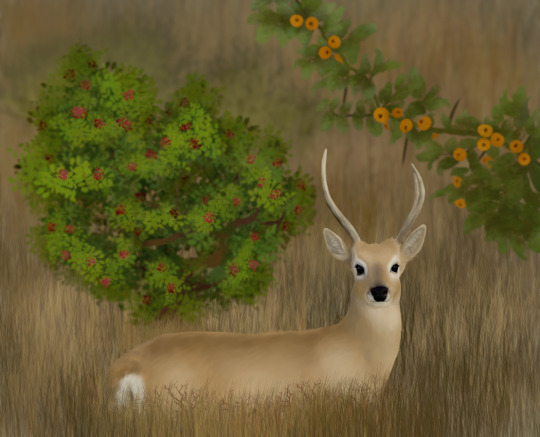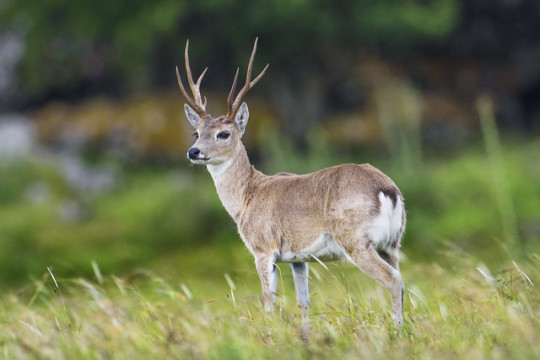#Ozotoceros bezoarticus
Explore tagged Tumblr posts
Text

Deercember Day Twenty-One: Pampas Deer | Holly and Hawthorn
The pampas deer (Ozotoceros bezoarticus), also known as veado-campeiro in Portuguese and as venado or gama in Spanish, lives in the grasslands of South America at low elevations, specifically across Brazil, Uruguay, Paraguay, Argentina, and Bolivia. Their common name is derived from the pampas (from the Quechua pampa, meaning "plain"), which are fertile South American low grasslands. It is the only species in the genus Ozotoceros. Their habitat includes water and hills, often with winter drought, and grass that is high enough to cover a standing deer. Many of them live in the Pantanal wetlands, where there are ongoing conservation efforts, and other areas of annual flooding cycles. Human activity has changed much of the original landscape. Pampas deer are among the most genetically polymorphic mammals: their current high nucleotide diversity shows that they had very large numbers in the recent past. They are known to live up to twelve years in the wild, longer if captive, but are threatened due to over-hunting and habitat loss. Many people are concerned over this loss, because a healthy deer population means a healthy grassland, and a healthy grassland is home to many species, some also threatened. Additionally, the pampas deer are very curious and like to explore; although this is endearing to observers, their lack of fleeing at the sight of humans makes them easier for poachers to kill. They will often stand on their hind legs to reach food or see over something. They are sedentary, with no seasonal or even daily migration. They usually feed regularly during the day, but sometimes have nocturnal activity. They may share their range with common crop plants including yerba mate (Ilex paraguariensis)—native to Brazil, Uruguay, Paraguay, and Argentina, and cultivated elsewhere—and tejocote (Crataegus mexicana), or Mexican hawthorn—native to Mexico and Guatemala, but has been introduced in the Andes and also cultivated elsewhere. Yerba mate is a plant species of the holly genus which is used to brew a caffeine-rich tea called mate when hot, and served cold alongside other components as tereré. Tejocote fruit is one of the most useful among hawthorns, and is consumed cooked, raw, and canned, or brewed into a hot fruit punch known as ponche. More information about pampas deer here, yerba mate here, and tejocote here.
References: Deer and Background, Holly 1, Holly 2, Hawthorn.
#I am once again asking myself to finish prior to 3a - 4a#least now I get to sleep forever because no work until TUESDAY#not that I work a whole lot but this lets me sleep in more#a little on the fence about my shading here but I got tired of fussing with it#the specific blur and focus on the plants makes up for it to me#as always‚ I am very proud to have found a range of species which could potentially coexist#Deercember#realHum#Art#Drawing#deer#deer art#pampas deer#veado-campeiro#venado#gama#Ozotoceros bezoarticus#Ilex paraguariensis#Crataegus mexicana
3 notes
·
View notes
Text
In this country nobody goes on foot, and the deer knows man as its enemy only when he is mounted and armed with the bolas.
"Journal of Researches into the Natural History and Geology of the Countries Visited During the Voyage of H.M.S. Beagle Round the World, 1832-36" - Charles Darwin
#book quote#the voyage of the beagle#charles darwin#nonfiction#deer#cervus campestris#ozotoceros bezoarticus#pampas deer#enemy#armed and dangerous#bolas
0 notes
Text

Mato Grosso pampas deer Ozotoceros bezoarticus leucogaster
Observed by luciano_bernardes, CC BY-NC
#Mato Grosso pampas deer#Ozotoceros bezoarticus leucogaster#Cervidae#deer#South America#Brazil#Mato Grosso do Sul
27 notes
·
View notes
Text

Rusa pampas (Ozotoceros bezoarticus) adalah sebuah spesies rusa yang hidup di dataran rumput elevasi rendah di Amerika Selatan.[3] Mereka dikenal dengan nama veado-campeiro dalam bahasa Portugis, dan venado atau gama dalam bahasa Spanyol. Spesies ini menjadi satu-satunya dalam genusOzotoceros.
0 notes
Photo

Pampas deer (Ozotoceros bezoarticus)
Photo by Cláudio Dias Timm
#pampas deer#ozotoceros bezoarticus#ozotoceros#rangiferini#capreolinae#cervidae#ruminantia#pecora#cetruminantia#artiofabula#artiodactyla#laurasiatheria#boreoeutheria#eutheria#scrotifera#euungulata#mammalia#tetrapoda#vertebrata#chordata
147 notes
·
View notes
Text
Los venados de campo en Salto tienen índices bajos de carga parasitaria, según estudio
Los venados de campo en Salto tienen índices bajos de carga parasitaria, según estudio
Por Santiago MagniSantimagni93 Desde hace muchos años la investigadora del Instituto de Investigaciones Biológicas Clemente Estable (IICBE), Susana González, en el área de la genética de la conservación, con énfasis en el venado de campo (Ozotoceros bezoarticus). Este año, pandemia mediante, junto a varios investigadores comenzaron un plan de acción para esta especie. Un primer muestreo en el…

View On WordPress
0 notes
Text
Catastrophic fires sweep through iconic Brazilian national park
http://bit.ly/2iqmWaL Firefighters observe the Chapada dos Veadeiros National Park wildfire from a helicopter. Photo by Fernando Tatagiba / ICMBio The piercing cries of blue macaws could be heard rising through the forests as flames approached the birds’ nestling chicks. For 12 days, the Chapada dos Veadeiros National Park, located in the state of Goiás, endured the largest and most damaging fire in its history, in a year when record wildfires — mostly human-caused — have engulfed vast areas of the Amazon and forests in other parts of Brazil. A team of more than 200 firefighters and logistical advisors worked day and night to contain the fire, which has destroyed at least 65,000 hectares (160,000 acres) of habitat. Highway police, Goiás state firefighters and Federal Military Police, supported by tanks and helicopters, all fought the intense blaze. The park is one of the most important and most visited conserved areas in Brazil. A foremost tourist destination, it receives 60,000 visitors yearly. The preserve is located atop an ancient, 1.8 billion year-old plateau in Brazil’s highly biodiverse Cerrado biome. It is home to endangered and endemic species, including the pampas deer (Ozotoceros bezoarticus), maned wolf (Chrysocyon brachyurus) and jaguar (Panthera onca) — all listed as Near Threatened by the IUCN. The park boasts 350 to 400 species of vascular plants per hectare, one reason why Chapada dos Veadeiros is a UNESCO World Heritage site. On Saturday, 28 October, rain fell on the park for the first time in a month, significantly reducing the…
0 notes
Text

Cerrado pampas deer Ozotoceros bezoarticus bezoarticus
Observed by thiagoantunes, CC BY-NC
17 notes
·
View notes
Photo

Argentine pampas deer Ozotoceros bezoarticus celer
Observed by solear, CC-BY-NC
6 notes
·
View notes
